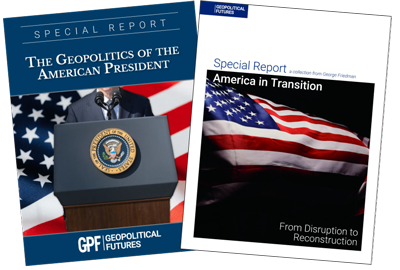Readers have no doubt noticed that much of my writing over the past two-and-a-half years has focused on Russia. Some of the reasons for this are obvious: Russia is a global military power. It is not a great economic power, but it has the capacity, along with the United States, to shape and control events on many continents. I’m deliberately excluding China from this analysis, which I’ll explain in my next article. Other powers are less apparent but no less important, and you can see them in the map below – if you know where to look.
Iran is the center of what I call the northern crisis. Its government has a geopolitical imperative to retain its frontiers, and it pursues this imperative, as many do, through the deployment of armed forces and weapons (or, at times, the appearance of deployment). This pursuit potentially threatens the countries on its eastern frontier – Pakistan, Afghanistan and Turkmenistan – as well as Turkey to the northwest. Most important to me, however, is that it could also threaten Russia. Iran’s intentions and capabilities are often uncertain, but in a world of complex strategy you must prepare for the worst, and in this region the worst is what usually happens.
Of all Iran’s neighbors, Russia alone is in a geographical position to act throughout the region. Iran knows as much and is thus compelled to act against Russia. It is tempting to consider this a dangerous course if not for the fact that Iran is developing nuclear capabilities that will likely deadlock any confrontation with Russia. They had minimally good relations previously, and now seem to be collaborating more strongly. Indeed, Russia has said it would counter any attack on Iran’s nuclear facilities – an obvious effort to draw closer to Iran and to try to intimidate the West. Meanwhile, Russia is reportedly selling drones to Uzbekistan, Kyrgyzstan and Kazakhstan, arming the area to Iran’s north with weapons that can likely reach its nuclear facilities. Russia is also attending meetings with governments in that region, including Turkmenistan, Uzbekistan and Iran, drawing closer to them.
This policy seems contradictory, a set of decisions that could hardly be described as a strategy. However, a closer look reveals that Russia is simultaneously building a significant force while pretending to be harmless and confused. Engaging Central Asia has been central to its regional strategy for years, and now, in arming the region’s governments, Russia has left its intentions toward Iran unknown. Coupled with guarantees to defend Iran from the West, this creates a strategy that is dangerous to Russia’s enemies due in large part to the uncertainty of its actions.
It also reveals what Russia might prepare for in a future reckoning with Iran. Moscow is clearly creating a defensive line in Central Asia. Iran is the most powerful force in the region south of Russia, but an attack by another major power, if successful, would force Iran northward to Russia’s line. Russia shares few interests with Iran and has no desire to defend it. It doesn’t want Iran to retreat to its defensive line, but neither does it want to attack Iran. It seems that Russia’s true intention is to contain Iran.
If so, my concerns about Russia would be misplaced. The point is that I don’t know what’s true because Russia’s strategy for Iran is deliberately unclear – as are its intentions for a defensive line in Central Asia that frightens Iran, or at least leaves it unsure.






 America in Transition &
America in Transition &